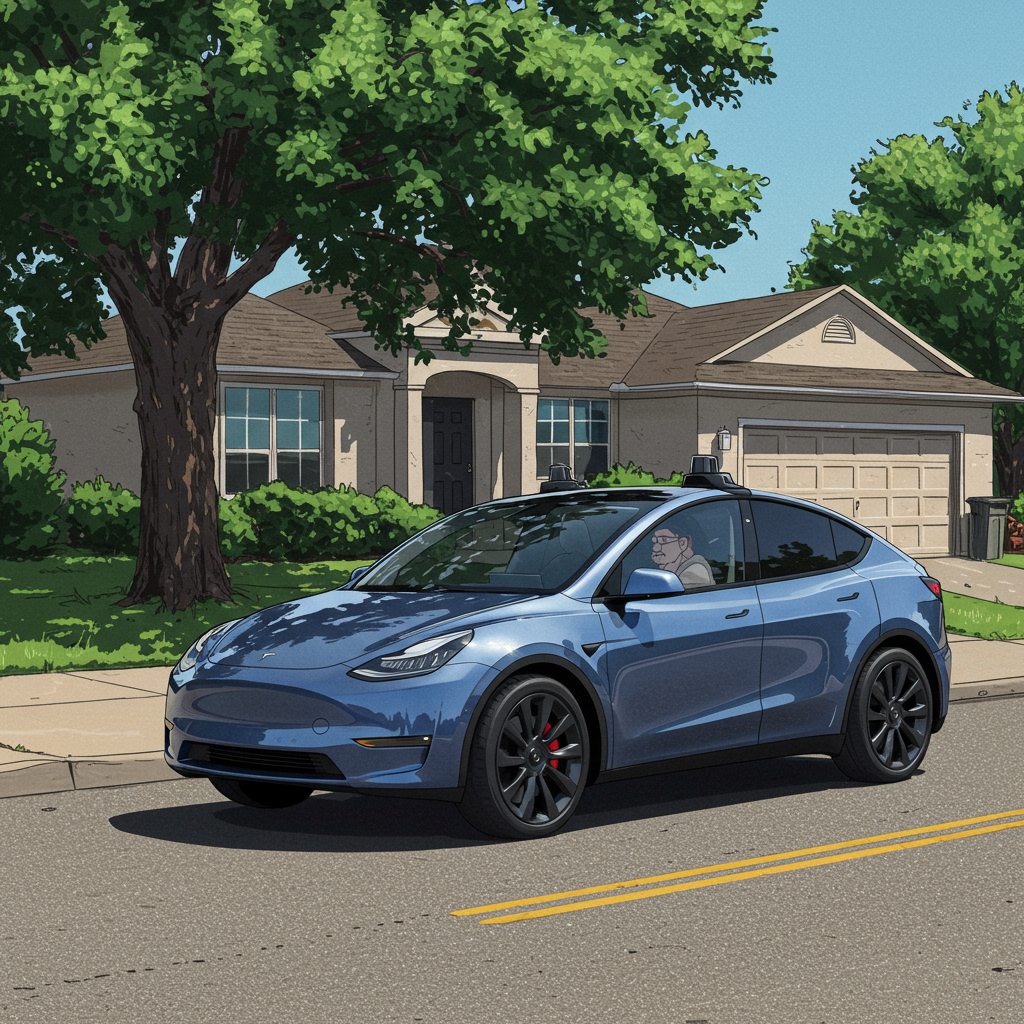A groundbreaking moment recently shook the automotive world: a Tesla model Y successfully drove itself from the production line directly to a customer’s home. This unprecedented autonomous delivery occurred in Austin, Texas, marking what CEO Elon Musk described as a potential industry first. The event took place on June 27, building upon tesla’s ongoing advancements in self-driving technology and setting a new benchmark for vehicle logistics.
This significant milestone demonstrates the tangible progress of Tesla’s Full Self-Driving (FSD) system beyond controlled tests. It signifies a step closer to a future where purchasing a vehicle might not require a trip to a dealership or reliance on traditional car haulers for the final leg of delivery. The successful completion of this driverless journey on public roads highlights the capabilities Tesla is rapidly deploying.
The Driverless Journey: A Detailed Look
The historic autonomous delivery involved a Tesla Model Y departing from the Gigafactory Texas in Austin. Its destination was a customer’s private residence located across town. The journey, confirmed by Elon Musk, was completed entirely autonomously, meaning there was no human driver behind the wheel and no remote operator controlling the vehicle at any point during the trip.
Tesla’s Head of AI, Ashok Elluswamy, provided further details on the feat. He noted that the Model Y navigated a mix of city streets and public highways. Impressively, the car reached speeds of up to 72 mph on the highway while adhering to all applicable traffic laws. This technical execution underscores the system’s ability to handle complex real-world driving scenarios without human intervention.
Why This Delivery Is Considered a Milestone
Elon Musk explicitly stated that this instance appeared to be the first time a production car had driven itself directly from a factory to a customer on public highways without any human or remote control. While autonomous vehicle companies like Waymo and Aurora are testing in Texas, their focus often differs, potentially involving more restricted operational design domains or not specifically targeting end-to-end customer delivery from a manufacturing site.
This Tesla Model Y autonomous delivery is being hailed as a “real use of the tech,” moving autonomous capabilities beyond test tracks and geofenced robotaxi services into a novel application for customer convenience and logistical efficiency. It’s a tangible demonstration of Tesla’s Full Self-Driving system performing a complete, practical journey.
Powering Autonomy: Tesla’s Full Self-Driving Technology
The technology enabling this autonomous delivery is Tesla’s Full Self-Driving system. This system relies on a vision-only approach, utilizing an array of external cameras to perceive the environment. Tesla asserts that all vehicles produced today are equipped with the necessary camera hardware to eventually achieve full autonomy.
A core component of Tesla’s strategy is leveraging data from its vast global fleet. Millions of Tesla vehicles on the road constantly collect data, training the autonomous system on an enormous range of driving scenarios, including unusual ones. Musk has claimed this extensive dataset allows the system to become significantly safer than human drivers, potentially “10, 20, 30 times safer,” due to its ability to perceive in all directions simultaneously and its lack of fatigue or distraction.
FSD Levels and Tesla’s Ambitions
Currently, the publicly available version of Tesla’s Full Self-Driving in the US operates as a Level 2 system. This means the vehicle can handle certain driving tasks, but a human driver must remain attentive and ready to take control at all times. This is the legal classification, with the human driver legally responsible.
However, Tesla’s goal, as outlined by Elon Musk, is to transition to Level 4 autonomy by 2025 in specific US states like Texas and California. Level 4 allows the vehicle to operate independently within defined conditions or geographical areas without requiring human supervision. The ultimate aim is Level 5 autonomy, signifying full self-driving capability in all conditions and locations, though this is a much longer-term objective.
Autonomy in Context: Beyond Just Delivery
The Tesla Model Y autonomous delivery on June 27 fits into Tesla’s broader push toward widespread autonomy. Just days before, on June 22, Tesla launched its Robotaxi service in Austin, Texas, via an Early Access Riders Program. Initially, these robotaxis involved a safety monitor, but Musk had indicated a goal for public hailing by the end of June 2025.
The development of unsupervised FSD is also critical for future products like the Cybercab. This planned two-seat, two-door autonomous electric taxi is slated for a 2026 launch on US roads with a target price below $30,000. The success of autonomous operations, whether for delivery or ride-hailing, is foundational to these upcoming ventures.
The long-term vision for autonomous deliveries extends beyond this single test. The plan is for vehicles to be transported by hauler to a local point, perhaps a delivery center, and then drive themselves the remaining distance to the customer’s home. While this full implementation is expected to take several years, the June 27 event represents a significant first step in validating this logistical model.
Navigating Timelines and Regulatory Challenges
While the successful autonomous delivery is a notable achievement, it’s important to consider Tesla’s history with ambitious timelines. Elon Musk has previously acknowledged being “a little optimistic” regarding the speed of FSD development. Claims of achieving full autonomy have been made in prior years, such as being able to sleep in a car driven autonomously by the end of 2020 (stated in 2019).
Achieving genuinely unsupervised, all-condition autonomy by 2025, as currently targeted for certain US states, would still be a massive leap and potentially make Tesla the first automaker to reach this level. However, widespread deployment, especially globally in markets like Australia, faces significant regulatory hurdles. Autonomous vehicles are not yet legal for sale and operation on public roads in many regions, and differing legal landscapes will likely mean a multi-year gap between US availability and international rollout.
Frequently Asked Questions
What was the specific event of Tesla’s first autonomous delivery?
On June 27, 2025, a Tesla Model Y successfully drove itself autonomously from the Gigafactory Texas in Austin directly to a customer’s home across town. According to CEO Elon Musk, this marked the first known instance of a production car completing such an end-to-end, driverless delivery journey on public roads without any human or remote control. Tesla’s Head of AI confirmed the car navigated both city streets and highways, reaching speeds up to 72 mph while following traffic rules.
Where did this autonomous Tesla delivery take place?
The groundbreaking autonomous delivery by a Tesla Model Y occurred in Austin, Texas. The vehicle began its journey at the Tesla Gigafactory Texas located near Austin and concluded at a customer’s private residence within the same city. This specific event demonstrates the system’s capability to handle routes from a manufacturing facility to a consumer location within a metropolitan area.
When might Tesla’s autonomous delivery become widely available to customers?
While the June 27 event was a singular, historic test, widespread availability of autonomous delivery is a long-term goal for Tesla. The company’s current focus is on refining its Full Self-Driving (FSD) technology to achieve unsupervised capability, targeted for specific US states around 2025. The full logistical vision involves vehicles being transported partially by hauler and then self-driving the final distance, which is expected to take several years to implement broadly. Regulatory approvals will also play a significant role in determining rollout timelines across different regions.
Conclusion
The successful autonomous delivery of a Tesla Model Y from the Austin factory to a customer’s home represents a major technical achievement for Tesla and a significant step forward for autonomous vehicle technology. While this was a single event, it provides a compelling real-world demonstration of the capabilities of Tesla’s Full Self-Driving system. This milestone not only previews a potential future for vehicle logistics, offering unprecedented customer convenience, but also underscores Tesla’s ongoing progress in its ambitious pursuit of widespread autonomy, forming a critical piece of its larger strategy that includes Robotaxis and future autonomous vehicles like the Cybercab.



